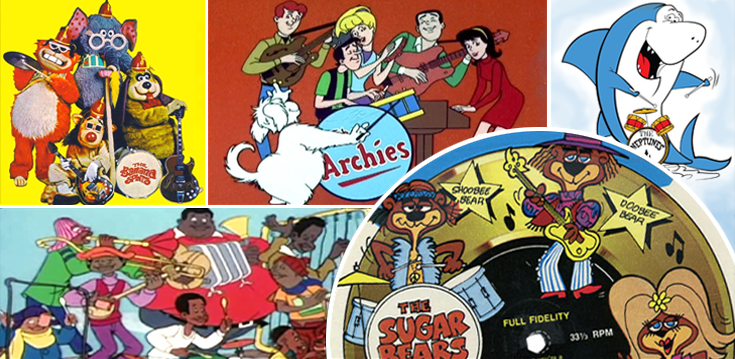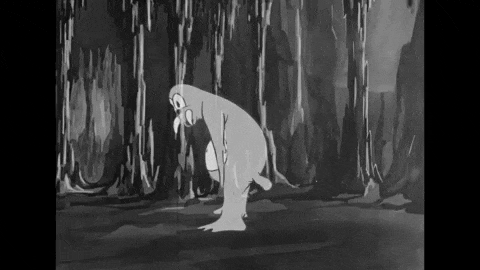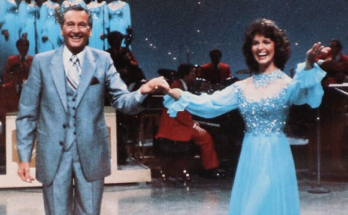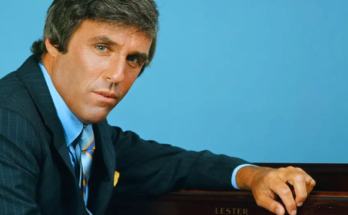
In 2020 cartoon bands routinely sell out arenas all over the world (Gorillaz), set — and then break — new album sales records for their genre (Dethklok) and even get second lives in feature film reboots (Jem and the Holograms, Josie and the Pussycats, the Banana Splits). But there was a time when animated rock & rollers were pawns of an unlikely cadre of advertising agencies, junk food corporations and assembly-line bubblegum music producers. That time was the late 1960s through the mid-’70s, and its dayglo impact on a generation of sugary cereal-fueled kids still reverberates today.
But where did the cartoon band as a concept begin? Going all the way back to the earliest sound movies, music was a major ingredient in animation. Who can forget the Fleischer Brothers’ Betty Boopified treatment of “Minnie the Moocher,” which utilized rotoscoping technique to turn Cab Calloway’s filmed performance into that of a ghostly walrus, all the way back in 1932?

The Fleischers produced not only the Betty Boop cartoons but also the famous Screen Songs series that encouraged theater audiences of the 1930s to “follow the bouncing ball” and sing along to popular tunes of the day; the earliest of these actually predated “The Jazz Singer” by two years. Warner Brothers kept their animation department busy cranking out Looney Tunes and Merrie Melodies shorts — including the memorable 1946 Chuck Jones cartoon “Quentin Quail,” the punchline of which rests on a baby quail refusing to eat a worm because it “looks like Frankie Sinatra.” Disney, perhaps predictably, upped the game entirely with the bold and beautiful feature-length exploration of musical visualization that is “Fantasia.”
None of that, however, really qualifies for this discussion. If there’s a Big Bang for the concept of the virtual band, it has to be the 1958 release of “The Chipmunk Song (Christmas Don’t Be Late),” credited to David Seville and the Chipmunks. Ostensibly sung by a trio of anthropomorphized chipmunks overseen by a human manager/father figure, all four of the voices on the record actually belonged to crafty singer-songwriter Ross Bagdasarian, just coming off a huge novelty hit with “Witch Doctor,” which used the same tape speed manipulation gimmick. (The actual speed vocal recording is an illuminating listen.)
“The Chipmunk Song” went to number one and won three Grammys. A Chipmunks comic book debuted the next year and in 1961 the animated “Alvin Show” appeared on CBS — in prime time. The band would go on to be revived nearly two decades later by Bagdasarian’s son with themed albums such as “Chipmunk Punk” and “Urban Chipmunk,” followed by a successful reboot of the TV cartoon and eventually a series of big-budget Hollywood films.
1958 was a pretty good Petri dish for the creation of the virtual band. The pop idol as we have come to know it was just coming into focus as television homogenized entertainment from coast to coast and youth culture was climbing out of its primordial ooze. The Jet Age was a time that practically satirized itself, and cartoons were right there to hold up the mirror.
“The Jetsons” jumped in with both feet, offering up “A Date with Jet Screamer” as the second episode of its debut season in 1962. Actor/director Howard Morris, most famous as the demented hillbilly Ernest T. Bass from “The Andy Griffith Show,” flexed his rockabilly pipes in the role of the titular rock star, still being roughly modeled on Elvis, as this was more than a year before the Beatles instantly and forever transformed the idea of what was a rock star looked like.
1965, the year the animated Beatles TV program debuted, was a musical one for “The Flintstones,” too. The season started with an episode depicting toddlers Pebbles and Bamm-Bamm singing the saccharine “Open Up Your Heart and Let the Sunshine In,” which became an unlikely easy listening radio hit. (Pebbles and Bamm-Bamm would later be rebooted as teenage musicians but never got this much attention ever again.) That same year the show riffed on the Beatles with an appearance by Stone Age moptops the Way Outs, then got the actual band the Beau Brummels to play caveman versions of themselves — as the Beau Brummelstones.
Now here is where the rubber meets the road. In 1966 NBC-TV launched a live-action prime-time TV series about a fictional band of Beatles wannabes called “The Monkees.” The idea was to cherry-pick songs written by professional pop composers — Goffin & King, Boyce & Hart, Neil Diamond, John Stewart, etc. — and record them with the actors singing over music played by professional studio musicians.
But in an entirely unexpected and shocking turn of events, the four actors cast in the roles of the Monkees were all actually really talented musicians who, through prolonged assertion against their handlers, managed to turn the virtual band into a real one that spit out 21 Hot 100 singles over a career that has since gone on more than half a century.
In the beginning the Monkees’ musical direction was overseen by the legendary “Man with the Golden Ear,” Don Kirshner, but he managed to piss off both the band and the record label, eventually forcing his exit from the project. Don Kirshner, however, was a shrewd man, and when he left, he took the virtual band idea with him.
Enter the Archies. Based on the eternal teenagers of the Archie comic books, which had already been around for three decades by this point in time, the TV series animated by Filmation would serve not just as Saturday morning kiddie entertainment, but also — like “The Monkees” — an ongoing advertisement for an endless string of bubblegum singles written by a stable of faceless songwriters. Unlike the Monkees, however, the musicians in the Archies would never argue back.
Ron Dante, the most in-demand male studio singer of his era, was cranking out as many as six factory-made pop tunes a day when he sang lead on two of the biggest hits of 1969 — the Cuff Links’ million-selling hit “Tracy” (on which Dante sang something like 20 vocal tracks in a layered arrangement) and the Archies’ “Sugar, Sugar,” which spent four weeks at number one on the Billboard Hot 100 and went on to become the best-selling single of the entire year. The Archies, with help from journeyman pop songwriters Jeff Barry and Andy Kim, eventually landed six songs in the Hot 100, including a Top Ten million-seller with “Jingle Jangle” (featuring Dante singing in falsetto as both Betty and Veronica).
Kirshner wasn’t the only one seeing dollar signs in the virtual band concept. TV animation legends William Hanna and Joseph Barbera, creators of timeless characters Tom & Jerry, Yogi Bear, Quick Draw McGraw, Huckleberry Hound, the Flintstones, the Jetsons and countless others, wanted in, too. They developed their own idea for a kiddie show featuring a mix of live-action zaniness, cartoon serial segments and bubblegum music. For help with costuming and character design they approached the famous puppeteer brothers Sid & Marty Krofft — who were just about to spring their own insane H.R. Pufnstuf on an unsuspecting world — and the Banana Splits were born.
Drawing on the talents of a remarkable group of writers and musicians that included Al Kooper, Barry White, Gene Pitney, Jimmy Radcliffe and bubblegum king Joey Levine, the Banana Splits released a series of singles that tended to err on the heavier and more soulful side of bubblegum. These would be “performed” onscreen by actors dressed up as Fleegle, Bingo, Drooper and Snorky, then pumped out coast-to-coast every Saturday morning in a program sponsored by Kellogg’s cereal. Though only the show’s theme song managed to creep into the Hot 100, the catchy, fuzzy soul jam “I Enjoy Being a Boy (in Love with You)” also earned substantial radio airplay.
The C.W. Post company countered this by creating a cartoon band around their friendly Sugar Bear mascot and placing them in commercials for their Super Sugar Crisp cereal. Featuring vocals by Mike Settle (from New Christy Minstrels and Kenny Rogers’ First Edition) and a young Kim Carnes, the single “You’re the One” made it all the way up to number 51 on the Hot 100. As a bonus, Post released a Sugar Bears extended-play record that kids actually cut off the back of the cereal box!
By this time Hanna-Barbera was about to launch one of its most enduring properties, a cartoon series about a group of teenagers and their canine sidekick who drive around in a psychedelic van solving mysteries. Scooby-Doo (originally named Too Much) and his human counterparts were conceived by creators Joe Ruby and Ken Spears as a rock band (the Mysteries Five) that got into wacky adventures, but over the course of multiple retoolings, the musical element was discarded.
Whether “Scooby-Doo, Where Are You?” would have gone on to be the family entertainment juggernaut it is today had Fred, Velma, Daphne and Shaggy taken up instruments will forever remain unknown. But the remarkable success of the show taught Hanna-Barbera that they could build countless other series around a similar framework — a gang of young people with an animal sidekick stumbling across mysteries and solving crimes.
Elsewhere in mystery and crime, the popularity of the James Bond novels and films, coupled with the real-life Cold War, had made the spy thriller a hot trope of the ’60s. TV shows such as “The Man from UNCLE,” “I Spy” and “Get Smart!” enjoyed high ratings, and it seemed only a matter of time before Saturday morning kiddie television got hip. ABC filled the gap with a big-budget live-action spy series in which all the actors were chimpanzees, dressed up in elaborate costumes on chimp-sized sets, even riding around on real Kawasaki dirtbikes.
The show was called “Lancelot Link, Secret Chimp,” and you know I wouldn’t be bringing it up here if there wasn’t a band involved. Yes, dear reader, I present to you: Lancelot Link and the Evolution Revolution. And yes, this was really on Saturday morning TV on a major network in 1970. Why was there a band of a freaked-out hippie chimps in a series otherwise dedicated to parodying the spy thriller? It turns out there is an answer for that: The band’s fuzzed-out psych-pop songs contained secret spy messages.
Meanwhile, back at Hanna-Barbera, the stage was set for the creation of a succession of half-hour Saturday morning cartoons more or less following the Scooby-Doo format — but in many cases, portraying the characters as musicians and including bubblegum pop songs in each episode.
They beat Filmation to the punch in expanding the animated Archieverse in 1970 with “Josie and the Pussycats,” a series centered on the lives of the titutar all-female rock trio (including real-life singing from pre-fame Cheryl Ladd and soul singer Patrice Holloway), but Filmation launched an all-out musical counterassault with “The Groovie Goolies,” a show about famous movie monsters — coincidentally existing alongside Sabrina the Teenage Witch in the Archieverse — who not only have their own band, but share screen time with no fewer than four other bands made up of ghosts and ghouls. There was the Bare Bones Band, the Mummies and the Puppies, the Rolling Headstones and the Spirits of ’76, each with their own spooky visual puns and musical styles.
At this point, real life bubblegum bands were ready to cash in on the Saturday morning TV action, just as the Beatles had done before them. Rankin-Bass, the animators behind the enduringly popular stop-motion Christmas specials of the ’60s and ’70s, produced shows featuring cartoon versions of the Jackson 5ive and the Osmonds. A decade before he became a teen heartthrob, Rick Springfield starred as a singing cartoon version of himself in “Mission Magic,” which also featured the magical teacher Miss Tickle (get it?), who bears more than a passing resemblance to a certain Ms. Frizzle from a much later cartoon series.
Hanna-Barbera continued their roll with “The Amazing Chan and the Chan Clan,” a cartoon update of the old Charlie Chan detective stories, this time depicting the erstwhile Chinese sleuth as the father of ten children who also happen to double as a sunshine pop group. (Yes, there’s a dog. His name is Chu Chu.) Perhaps predictably, the Chan Clan’s music sounds pretty much exactly like that of the era’s most popular virtual family band, the Partridge Family. (We’re not even going to go into the Brady Kids.)
Next in the H-B musical lineup came Butch Cassidy and the Sun Dance Kids, with Monkee Micky Dolenz voicing drummer Wally. In this iteration, the band’s pet dog is called Elvis and they are advised by a powerful supercomputer named Mr. Socrates, who is somehow, according to a running gag on the show, allergic to dogs.
The last of the Hanna-Barbera cartoon bands of the golden age is the Neptunes (no, not Pharrell’s Neptunes), notable for playing all their gigs in a futuristic undersea world, and for having a great white shark for a drummer.
Jabberjaw, the shark in question, was written as a ripoff of both Curly Howard and Rodney Dangerfield, and his namesake show was even more of a one-note concept than most of these assembly-line series. Only 16 episodes were produced, and with that, the cartoon band as a staple of the Saturday morning TV lineup became more or less extinct.
Or did it? Fat Albert’s Junkyard Band, which had been singing songs with positive moral messages every Saturday morning since 1972, kept cranking out uplifting jams until somewhere around 1980, by which time the musical element was mostly dropped from the Filmation program.
And of course the iconic “Schoolhouse Rock” series combined catchy tunes with engaging animation to teach the entirety of Generation X about grammar, the legislative process, multiplication, women’s suffrage and electricity, among other things.
But there wasn’t another cartoon show built around a band until Jem and the Holograms in 1985 — and even on that show, the truly cool band was the villainous Misfits (no relation to the human cartoons also known as the Misfits). Beyond that, animated bands become mostly relegated to single episodes of cartoon series (the Be Sharps), or as an ongoing gag (Mystik Spiral, the Beets) or plot device (Hex Girls). In 2006, OutKast’s Andre 3000 brought back the social guidance vibe of “Fat Albert” with “Class of 3000” — and Dethklok debuted on Adult Swim’s “Metalocalypse,” bringing the hilariously nihilistic brutality of death metal into television animation (and up the charts, as well).
By that time, of course, Gorillaz had exploded into global consciousness. The highly collaborative joint project of Blur’s Damon Albarn and “Tank Girl” comic artist Jamie Hewlett has since sold well north of 15 million albums, sold out stadiums around the world and continues releasing new songs monthly in their Song Machine program.
It’s all quite a long way from Alvin and the Chipmunks, of course. But what’s next? With the rise of CGI and deepfake technology, the next wave of virtual bands could be made up of realistic live-action facsimiles of dead presidents, or supergroups of musicians dead or alive, or Marvel superheroes, or who knows what?
And will there be cereal?



